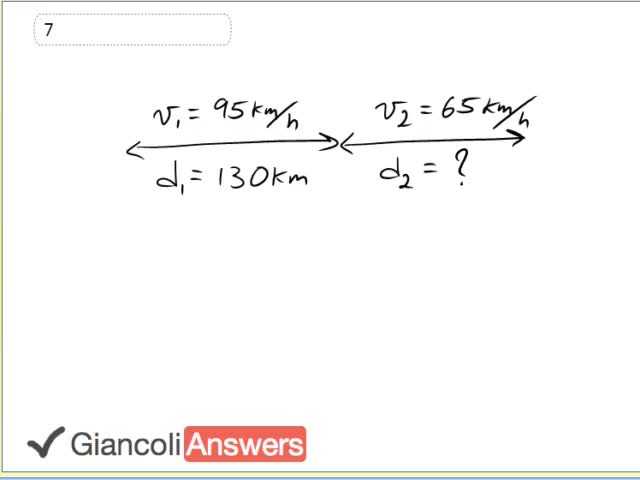
b)

In order to watch this solution you need to have a subscription.
You’re driving home from school and the question is: what is the total distance from the school to your home? You’re given the first distance of one hundred and thirty kilometers and after that distance the rain starts and you have to slow down from ninety five kilometers an hour to sixty five kilometers an hour. To answer this question you need to know what is the time interval for each of these intervals, so you have ‘t1’ for ‘d1’ and ‘t2’, after knowing those things we can figure out what ‘d2’ is by multiplying ‘t2’ by ‘v2’, and then we’ll get the total distance by adding ‘d1’ and ‘d2’. So to find ‘t2’ we’ll first need to find ‘t1’ and then subtract that from the total time which we’re given as three hours and twenty minutes. So ‘t1’ is: ‘d1’ divided by ‘v1’ which is one hundred and thirty kilometers divided by ninety five kilometers per hour which is one point three six eight four hours. The length of time to cover the second interval, ‘t2’ is: the total time minus ‘t1’, so that’s three hours and twenty minutes or three point three repeat hours minus one point three six eight four hours which equals one point nine six four nine hours as ‘t2’. ‘d2’ is: the speed during the second interval times ‘t2’, or sixty five kilometers per hour times one point nine six four nine hours giving us ‘d2’ to be one hundred and twenty seven point seven kilometers. So the total distance covered, which is going to be the answer to part ‘a’, is: ‘d1’ plus ‘d2’. So that’s one hundred and thirty kilometers given to us initially plus one hundred and twenty seven kilometers at the second interval giving us an answer of two hundred and fifty seven point seven kilometers or two point six times ten raised to the power two kilometers. For part ‘b’, the average speed, assuming that we’re travelling in a straight line and it indicates that by saying you’re driving steadily, it’s going to be the total distance of two hundred and fifty seven point seven kilometers divided by the total time of three point three three three hours. This gives: seventy seven kilometers per hour. Notice that you cannot take the arithmetic average of the two speeds to get the average speed, in other words, you can't go: ninety five kilometers per hour plus sixty five kilometers per hour all divided by two. The reason it doesn’t work is because these two different velocities occur for different lengths of time. If you had gone ninety five kilometers an hour and sixty five kilometer an hour for equal amounts of time then this particular calculation would happen to work. If you want to do a calculation like this, you could time-weight each speed, so you could go: ninety five kilometers per hour times the fraction of time during which you’re travelling at that speed, which is ‘t1’, one point one three six eight four hours divided by the total time of three point three repeat hours plus sixty five kilometers per hour the fraction of time you’re traveling at that speed, ‘t2’ which is one point nine six four nine divided by the total time, and this will give you the correct answer because you’ve time-weighted the two speeds. For the 5th Edition there are a few differences: ‘v1’ is actually sixty five miles per hour and ‘d1’ is one hundred and thirty miles instead of kilometers and ‘v2’ is fifty five miles per hour. Our process is going to be the same: one hundred and thirty miles divided by sixty five miles per hour, giving ‘t1’ as two point zero zero hours, ‘t2’ is one point three three three three hours, and ‘d2’ is fifty five miles per hour times one point three repeat, equaling seventy two point three miles. The 5th Edition total distance then is: one hundred and thirty miles plus seventy three point three miles, equaling two point zero times ten raised to power two miles. The average speed is going to be that total distance divided by time: two hundred and three point three three miles divided by three point three repeat hours, giving you sixty one miles per hour.